by Sam Tackeff | Nov 18, 2009 | Asian, Books, Japanese, Pantry Staples, Quick and Easy, Soups
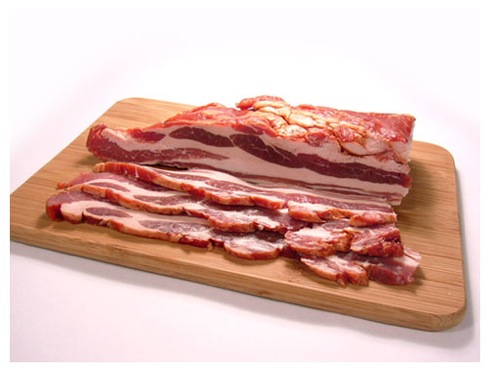 This week one of those hokey “name 3 things you like to eat, 3 places you’ve lived, and forward it to everyone!!!” emails circulated throughout my friends, with one noted similarity between all of our responses: It seems that we all have a voracious passion for bacon. Clearly our love for bacon will unite us for all time in friendship, so that’s exciting. And really who can blame us? There is so much you can do with the product – one slice lends entire flavor to soups, served crisply with eggs it is a miracle, even covered in chocolate there is demand.
This week one of those hokey “name 3 things you like to eat, 3 places you’ve lived, and forward it to everyone!!!” emails circulated throughout my friends, with one noted similarity between all of our responses: It seems that we all have a voracious passion for bacon. Clearly our love for bacon will unite us for all time in friendship, so that’s exciting. And really who can blame us? There is so much you can do with the product – one slice lends entire flavor to soups, served crisply with eggs it is a miracle, even covered in chocolate there is demand.
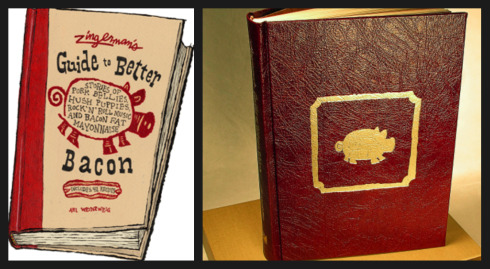 At the bookstore we have been selling copies of “Zingerman’s Guide to Better Bacon”, a rousing tour of bacon’s history (which for $300 you can get yourself a pigskin bound copy), as well as the Bacon Cookbook, which should have a prominent place in every bacon lover’s kitchen. In an unscientific poll that I’ve conducted, those most likely to buy these books were in a sub-set group of customers of which I include myself: the “JPAB’s”, say it: “Jay-Pab’s” or “Jews passionate about Bacon”. Maybe being deprived of bacon as a child led to my obsession, but really I think it’s actually a mix of deprivation and a greater cultural legacy- we Jews have a penchant for perfect savory brunch food – lox, whitefish, chopped liver, cream cheese, bagels – it’s no wonder that bacon sneaks itself in somehow.
At the bookstore we have been selling copies of “Zingerman’s Guide to Better Bacon”, a rousing tour of bacon’s history (which for $300 you can get yourself a pigskin bound copy), as well as the Bacon Cookbook, which should have a prominent place in every bacon lover’s kitchen. In an unscientific poll that I’ve conducted, those most likely to buy these books were in a sub-set group of customers of which I include myself: the “JPAB’s”, say it: “Jay-Pab’s” or “Jews passionate about Bacon”. Maybe being deprived of bacon as a child led to my obsession, but really I think it’s actually a mix of deprivation and a greater cultural legacy- we Jews have a penchant for perfect savory brunch food – lox, whitefish, chopped liver, cream cheese, bagels – it’s no wonder that bacon sneaks itself in somehow.
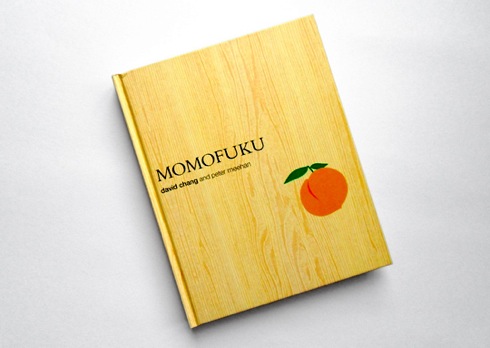 (Photo Helen Rosner/Eat Me Daily)
(Photo Helen Rosner/Eat Me Daily)
I’m always looking for new ways to use bacon, and most recently stumbled across a miracle in my new Momofuku cookbook – Bacon Dashi. Dashi, a traditional japanese stock made of konbu (kelp), and bonito flakes (dried fish, which has been powdered), is a staple broth that can be used in a myriad of ways. In the Momofuku cookbook, (of which a brilliant review can be found at Eat Me Daily), David Chang substitutes more easily findable smoky bacon for bonito, to create of this ever useful base broth. I made a batch last week, and have been using it in everything.
Things to use Momofuku Bacon Dashi for:
:: As the liquid for any soup, stew, grain, rice, or polenta. ::
Or:
1. Bacon Dashi over “stuff”: Slice shiitake mushrooms and green onions (scallions) in a bowl, and some silken tofu if you have it. Ladle hot Bacon Dashi over the contents of the bowl. Sit. Drink with glee. You know, I haven’t tried this, but I bet if you were to crunch up some of those onion strings that people put in green bean casserole in the bowl as well – it would taste good too.
2. Bacon Dashi Miso Soup – use the Bacon Dashi in this perfect and easy recipe for miso soup from Maki of Just Hungry.
3. Quick Bacon and Cabbage soup: Chop one strip of thick cut bacon and cook over medium high heat in a large soup pot. Add in one chopped onion and three minced cloves of garlic, and cook for about 4 or 5 minutes until slightly tender. Add in one chopped carrot, and rip in three leaves of sage. (If you have a potato, cube it into really small pieces, and add it here). Add a tin of cannelini beans, or great northern beans. Cook for about two minutes, and add 6 cups of Bacon Dashi – or a mix of water and dashi if you don’t have enough bacon dashi because you have used most of your double batch in the past few days. Bring to a boil, then turn down the heat, cover, and simmer for 20 minutes. Add in a half head of cabbage, roughly chopped, and 1 tablespoon of white miso paste and simmer for 10-15 more minutes. Season with some pepper, and serve.
*If you don’t have white miso paste, you could just salt at the end, but it wont have that nice unctuousness and depth that the miso adds to the soup. Buy yourself a little tub, and use it!
Momofuku Bacon Dashi
from the Momofuku Cookbook
Makes 2 Quarts
Two 3-by-6-inch pieces konbu (kelp)
8 cups water
1/2 pound smoky bacon, preferably Benton’s
1. Rinse the konbu under running water, then combine it with the water in a medium saucepan. Bring the water to a simmer over medium heat and turn off the stove. Let steep for 10 minutes.
2. Remove the konbu from the pot and add the bacon. Bring to a boil, then turn the heat down so the water simmers gently. Simmer for 30 minutes.
3. Strain the bacon from the dashi, and chill the broth until the fat separates and hardens into a solid cap on top of it. Remove and discard the fat and use the dashi or store it. Bacon dashi will keep, covered, for a few days in the refrigerator.
*Notes: All Asian grocery stores and most health food stores will carry dried konbu (kelp), although increasingly it is found in the Japanese part of the “world” section of the American supermarket. As to the bacon, I used Niman ranch thick cut apple-wood smoked bacon, and it worked out just fine.
*Also, you can half this recipe, or if you are smart, double it.
*Also, you can eat the konbu for snack instead of throwing it out. I wouldn’t advocate the same with the boiled bacon.
Other people using Bacon Dashi in creative ways:
Anticiplate: Southern Style Shrimp ‘n Grits
Inuyaki: Bacon Agedashi Tofu
by Sam Tackeff | Nov 12, 2009 | Food Travel, Ingredients, Local stores, Pantry Staples, Soups

A few weeks ago we headed down the California coastline to a tiny town named Pescadero, on a quest for beans. Pescadero, at the midway point between San Francisco and Santa Cruz – is known for a lovely beach, antiques, the historic artichoke soup at Duarte’s Tavern (which apparently Guy Fieri is a fan of), and the burrito joint in the gas station – but if you drive farther down the road you will get to a mystical and magical place named Phipps Country Store, which has both an unusually large selection of beans, and an unusually large selection of birds, small furry animals, livestock and antique stoves.

So, truthfully, I drove over an hour just to buy beans. But, oh what beans!!! Phipps brags over 50 types of beans, most of which are grown by them, using no sprays/chemicals. While I was there I picked up some chickpeas, runner beans, soup mixes, and chestnut runners, all glorious stuff.
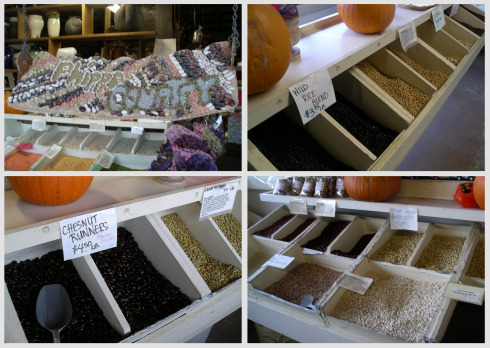
Included in my purchase was one really great package of red lentils and barley – that came with a recipe which I adapted for dinner.

This soup is perfect for the winter weather, and like most soups, tastes absolutely delicious for lunch the next day even if you are eating it cold. My twist is the miso – I use white miso, which adds a really nice depth of flavor to soups without it tasting miso-y or exotic. You can easily find white miso paste in the refrigerator section of any asian market, and I would highly recommend buying it to have on hand. If you can’t find miso, you could substitute bouillon.
Phipp’s Red Lentil Barley Soup
makes 8-9 1 cup servings
1 slice thick cut bacon (I use Niman Ranch)
1 cup (or 1 large) onion, chopped
1 cup (or three stalks) celery, chopped
2 cloves garlic, minced
1 can (28 oz) tomatoes, or 4 cups diced fresh tomatoes
3/4 cups red lentils, rinsed
3/4 cup pearl barley
4 cups water
2 cups low sodium chicken broth
1 tablespoon white miso paste
1/2 teaspoon dried rosemary, crushed
1/2 teaspoon dried oregano, crushed
1/4 teaspoon ground black pepper
1 cup shredded swiss cheese, or sharp cheddar (optional)
In a large heavy bottomed soup pot, place the slice of bacon over medium heat, until most of the fat is rendered. Add in the onions, celery and garlic, and cook until tender, about 10 minutes.
Add the water, chicken broth, miso paste, tomatoes, lentils, barley, rosemary oregano, carrots and pepper. Bring to a boil, and then turn down the heat and simmer gently for 40 minutes or until the barley, lentils and carrots are tender. Top with swiss cheese or sharp cheddar if desired. (It goes well with or without!). I made a small batch of salt and olive oil rolls from my refrigerated master dough from “Artisan Bread in 5 minutes a day” and it went perfectly with this.
Nutritional Information: (Per 1 cup serving, not including cheese) Calories: 158, Total Fat: 1.6 g, Sodium: 115.9 mg, Total Carbs: 29.3 g, Dietary Fiber: 6.5 g, Protein: 7.7 g
Phipps Country Store and Farm
2700 Pescadero Road, Pescadero, CA 94060
(650) 879-0787
Hours: 10:00 – 5:00 during winter, Closed Mondays
by Sam Tackeff | Nov 10, 2009 | Asian, Books, Seafood

MAKE THIS SHRIMP.
Jaden Hair, the most fabulous lady responsible for the Steamy Kitchen website, visited San Francisco this weekend for her very own book signing with us at Omnivore Books! I’ve been reading Jaden’s blog for several years now, and she is certainly one of the best out there. So, when word was out that she was finally coming out with a cookbook – I was psyched. Let me just say, her book is AWESOME – this shrimp is only one of the reasons!
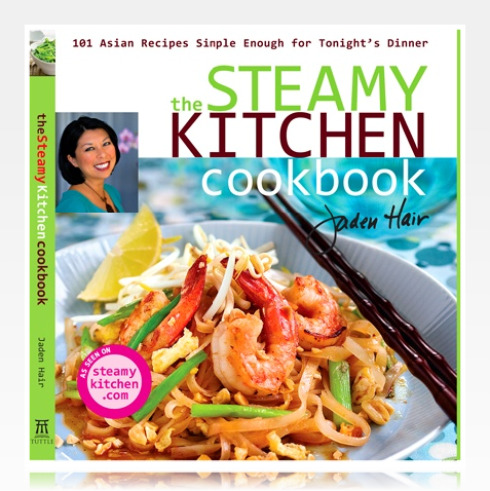
Among the other reasons why this cookbook is awesome, and you should get a copy:
1. It’s pretty! And she took all the photos *herself*. This is phenomenal for any cookbook author to be given such control over the layout of the cookbook. Inspiration for any budding food blogger, or really, just perfect for anyone who wants to be instantly hungry.
2. It features tasty and delicious Asian recipes, easy enough that anyone can make, even if you live hundreds of miles away from an Asian grocery and can only shop at a big-box . And, it’s really well organized – entertaining introduction, informative tools and a really great ingredient section where she goes into some depth about creating an asian-food friendly pantry – and helpful substitutions.
3. My copy is signed… in Pink Sharpie! Let me tell you, Jaden is as wonderful in real life as she comes across on her blog and in her cookbook. What a treat!
Isn’t she great? (Photo of Jaden at Omnivore Books, mid-pose, by Inuyaki)
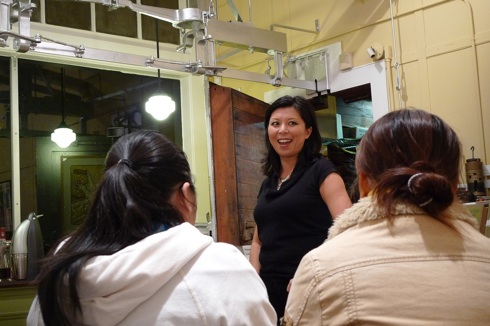
Jaden’s coconut shrimp is delicious. Shrimp, coconut, a little bit of booze – some of my favorite ingredients, period.
Tonight I went into the liquor store and purchased a mini bottle of cognac to use in a recipe, and after making it, let me tell you – I sure as heck wish I had bought the whole bottle so that I can make this one on a regular basis and not have to go back!
Jaden’s Coconut Shrimp (from The Steamy Kitchen Cookbook)
Serves 4 as part of a multi-course meal
(Or two hungry people!)
1/4 cup (20g) unsweetened shredded coconut
1 tablespoon high-heat cooking oil
1 lb (500 g) raw tail-on shrimp, deveined and patted really dry
2 tablespoons butter
4 green onions (scallions), cut into 2-in (5-cm) lengths
1 tablespoon finely minced garlic
3 tablespoons cognac (brandy or rum make good substitutes)
Generous pinch of salt
3/4 teaspoon sugar (omit if you are using sweetened shredded coconut)
1. In a wok or frying pan over medium eat, add the coconut and toast until golden brown. This should only take about 3 to 4 minutes. Take care not to burn the coconut! Once the coconut is toasted, immediately remove to a plate to cool.
2. Wipe the wok or pan dry and set over high heat. When a bead of water instantly sizzles and evaporates upon contact, add the oil and swirl to coat. Add the shrimp to the wok, keeping them in a single layer. Fry for 1 minute, flip and fry an additional minute until almost cooked through. Remove from the wok, keeping as much oil in the wok as possible.
3. Turn the heat to medium, add the butter and , once the butter starts bubbling, add the green onion and garlic. Fry until fragrant, about 30 seconds. Pour in the cognac and add the salt and sugar. Stir and return the shrimp to the wok. Let the whole thing bubble and thicken just a bit – the sauce should lightly coat the shrimp. Remove from the heat, sprinkle in the toasted coconut and toss well.
Wise Note to Self / everyone: I served this on brown rice – which was tasty – but for next time I will split the sauce equally and not hoard it all on my own plate. But it was oh-so-delicious!!!
by Sam Tackeff | Nov 7, 2009 | Chocolate, Gifts, Shopping
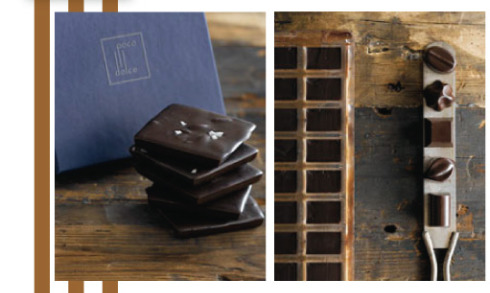
There is an empty canister of Poco Dolce Espresso Toffee chocolates sitting behind my desk at work. I’ve opened it every few days over the past couple of weeks hoping that it would miraculously be full again of chocolate. (You think I’m kidding – sadly I’m not.) I really should replace it before I go crazy for good.
I remember vividly the day that I had my first Poco Dolce chocolate square (they call them tiles). I had just completed a long walk, over two very big hills, and ended up at Chocolate Covered in Noe Valley – the fine purveyors of just about any chocolate you can think of eating. The interaction went something like this: Me: “JACK! I need a most delicious chocolate that I can eat immediately! I need something exciting! I need your best!” Jack: Knowingly hands me a Poco Dolce Aztec Dark Chocolate Tile flecked with Sea Salt.
Jumpin’ Jehoshaphat! – it was a like a multiple layer explosion.
Deep, dark chocolate. Spicy chile pepper with hints of cinnamon. Crunchy little toasted pumpkin seeds nestled in between. And flecks of salt that make the chocolate sing! You experience each individual layer and then they mix together and… I can’t come close to giving them justice, you really have to just try one.
And, the company is run by a smart and entrepreneurial woman, Kathy Wiley, here in San Francisco. I’ve been tempted to scream out “YOU GO GIRL” on the times that I’ve met her in the flesh, but that is embarrassing and a little ridiculous, and I really just think that aside from the fantastic chocolate, it’s just really inspiring to see women as leaders in the food industry.

Poco Dolce chocolate is a perfect stocking stuffer. Poco Dolce chocolate is a perfect afternoon snack, perfect breakfast, perfect gift for someone you really care about, perfect stress reducer, you name it. Poco Dolce chocolate is really just perfect. Do yourself a favor and buy some of these. You can thank me later. (Preferably with a shipment of Tile Trio).
Prices run from about $2.50 a square to $16 for an 8 oz canister of toffee squares, $18 for a box of 8 tiles, $22 for a sampler of toffee squares, to $50 for the Trifecta box of Tiles, sure to make you an instant hero to the special recipient. For chocolate of this quality and deliciousness a pretty good deal.
pocodolce.com
415.255.1443
info@pocodolce.com
Chocolate Covered
4069 24th St (between Castro St & Noe St)
San Francisco, CA 94114
(415) 641-8123
by Sam Tackeff | Nov 6, 2009 | Poultry
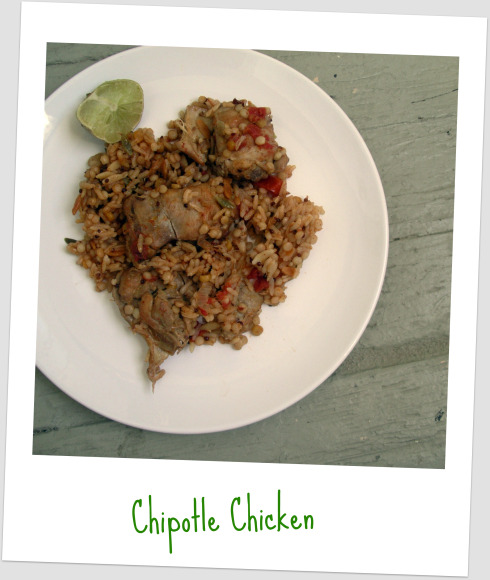
I think I’m having east coast withdrawal syndrome. In the form of seasonal food cravings, that is. In addition to the urge to hibernate, I’ve been fiercely craving hearty winter stews, even though the weather here in San Francisco has hit 70 or more a few times this week. In a pleasant departure from chili, bean soups, and lentils and refried beans which have been in heavy rotation these past few weeks, I was excited to stumble along this most delicious chicken chipotle casserole type thing. This smoky, spicy, savory, and hearty dish pretty much fulfilled my every craving.
After spending the day in the bookstore reading cookbooks all day long, I must admit that more often than not I head to the internet to find ideas for dinner. I’m a big fan of Martha Stewart’s website, and her Everyday Food Blog is a great source for easy weeknight meals – I found a version of this recipe with rice there, and decided to give it my own twists by changing up the grain. Israeli couscous, a type of little round pasta – goes great with the spicy chicken and chipotle peppers.
Chipotle Chicken with Mixed Grains
adapted from Martha Stewart Everyday Food
Serves 4
This recipe takes minimal prep time (about 15 minutes), but takes about an hour, including two 25 minute blocks that are completely unattended, so you will have plenty of time to check your email, watch a tivo’ed show, empty the dishwasher, play some cards, or whatever you want to do to wind down from the day.
2 tablespoons vegetable oil
8 boneless, skinless chicken thighs (1.5 to 2 pounds)
coarse salt (I use Maldon), and ground pepper
1 medium red onion, thinly sliced lengthwise
3 garlic cloves, roughly chopped
1 teaspoon ground cumin
2 canned chipotle chiles in adobo, minced (or 1 if you want a little less kick)
2 large tomatoes, roughly chopped
1 cup long-grain white rice, or mixed grains*
Optional: Lime wedges and Cilantro, for serving
*I used a mix of long grain white rice (a quarter cup was all I had left in the pantry since I’ve mostly switched over to brown), and added 3/4 cups of Trader Joe’s Harvest Grain blend, which includes israeli cous cous, orzo, garbanzo beans and quinoa, and it ended up being so delicious that I think this is the way to go.
1. Take out a big pot or dutch oven, and heat the oil on medium high heat. Then, working in batches, brown the chicken thighs, and set aside on a plate, seasoning lightly with salt and pepper. You want to work in batches so that the chicken browns – if the pan is too crowded it’s going to end up steaming them. This should take about 6 minutes or so, and you can start chopping the onions while the chicken cooks.
2. In the same pan, reduce the heat to medium, add your onions, and saute them for about five minutes until they start softening. Add your garlic, cumin, and chiles, and cook for about 3 minutes to let the garlic soften slightly. Add in your tomatoes, a teaspoon of salt, and stir for 3 more minutes. Finally, add a cup of water to the pot, and dump the chicken and juices back in, cover, turn the heat down slightly and let simmer for 25 minutes.
3. After 25 minutes, move some of the chicken to the side, and stir in rice and grains, making sure they are coated and submerged in the liquid, otherwise they won’t cook! Put the chicken back over, put the lid back on, and cook until rice and grains are cooked, about 25 more minutes.
4. Serve with lime wedges, cilantro, and a little sour cream or yogurt to cut the spice if you need it. Goes wonderfully with cheese quesadillas filled with Pepperjack, and also is delicious reheated or cold the next day for lunch.
 This week one of those hokey “name 3 things you like to eat, 3 places you’ve lived, and forward it to everyone!!!” emails circulated throughout my friends, with one noted similarity between all of our responses: It seems that we all have a voracious passion for bacon. Clearly our love for bacon will unite us for all time in friendship, so that’s exciting. And really who can blame us? There is so much you can do with the product – one slice lends entire flavor to soups, served crisply with eggs it is a miracle, even covered in chocolate there is demand.
This week one of those hokey “name 3 things you like to eat, 3 places you’ve lived, and forward it to everyone!!!” emails circulated throughout my friends, with one noted similarity between all of our responses: It seems that we all have a voracious passion for bacon. Clearly our love for bacon will unite us for all time in friendship, so that’s exciting. And really who can blame us? There is so much you can do with the product – one slice lends entire flavor to soups, served crisply with eggs it is a miracle, even covered in chocolate there is demand. At the bookstore we have been selling copies of “Zingerman’s Guide to Better Bacon”, a rousing tour of bacon’s history (which for $300 you can get yourself a pigskin bound copy), as well as the Bacon Cookbook, which should have a prominent place in every bacon lover’s kitchen. In an unscientific poll that I’ve conducted, those most likely to buy these books were in a sub-set group of customers of which I include myself: the “JPAB’s”, say it: “Jay-Pab’s” or “Jews passionate about Bacon”. Maybe being deprived of bacon as a child led to my obsession, but really I think it’s actually a mix of deprivation and a greater cultural legacy- we Jews have a penchant for perfect savory brunch food – lox, whitefish, chopped liver, cream cheese, bagels – it’s no wonder that bacon sneaks itself in somehow.
At the bookstore we have been selling copies of “Zingerman’s Guide to Better Bacon”, a rousing tour of bacon’s history (which for $300 you can get yourself a pigskin bound copy), as well as the Bacon Cookbook, which should have a prominent place in every bacon lover’s kitchen. In an unscientific poll that I’ve conducted, those most likely to buy these books were in a sub-set group of customers of which I include myself: the “JPAB’s”, say it: “Jay-Pab’s” or “Jews passionate about Bacon”. Maybe being deprived of bacon as a child led to my obsession, but really I think it’s actually a mix of deprivation and a greater cultural legacy- we Jews have a penchant for perfect savory brunch food – lox, whitefish, chopped liver, cream cheese, bagels – it’s no wonder that bacon sneaks itself in somehow. (Photo Helen Rosner/Eat Me Daily)
(Photo Helen Rosner/Eat Me Daily)










